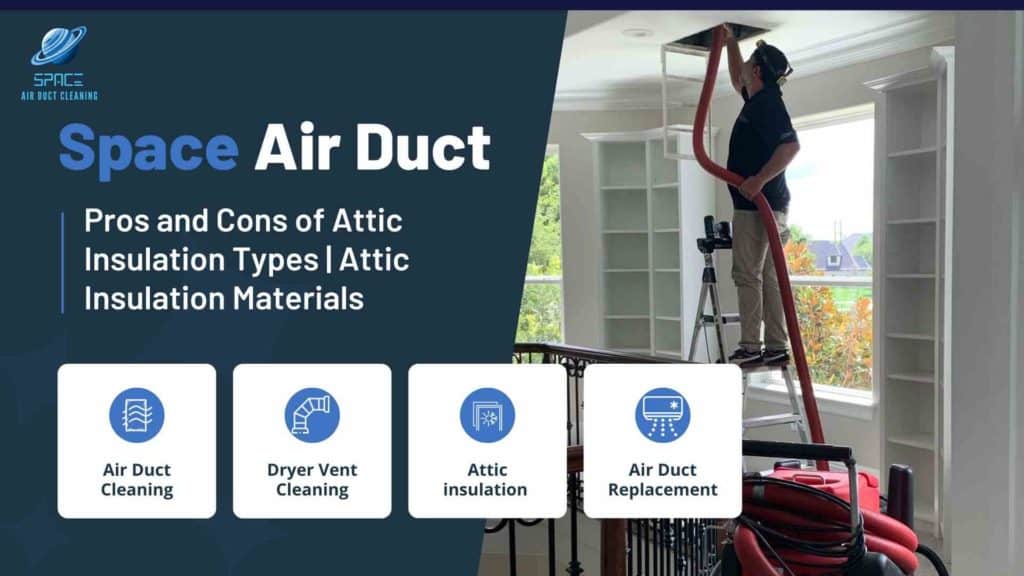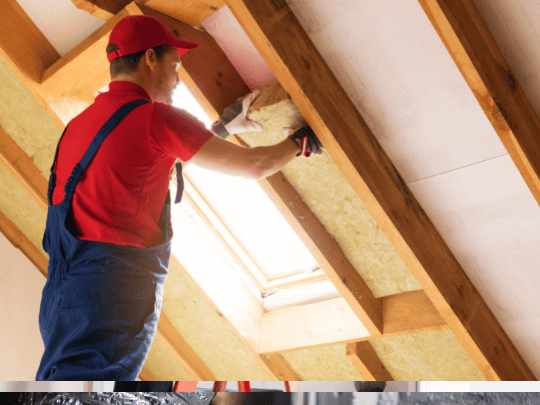The time of year is quickly approaching where we will be thinking about getting our homes ready for winter. One way to do this is by installing insulation in the attic. Insulation can help keep your home warmer and also improve the energy efficiency of your home! The type of insulation you choose is important. If a home has improper attic insulation, it can have negative effects on the energy efficiency and comfort of your home.
Different Types of Attics Insulation
There are many different types of insulation that you may not know much about. The most common types of insulation are fiberglass batts, cellulose, and mineral wool. Let’s take a look at the pros and cons of each type:
Fiberglass Batts Attic Insulation
Fiberglass batts are a common type of insulation. It is made of small glass fibers materials and is installed in between the joists in your attic.
Attic Insulation Pros
Fiberglass Batts attic insulations’ pros are, they are inexpensive to install. And they are fairly easy to install, especially with the proper equipment.
Fiberglass batts have very low air infiltration. This means that if you put enough insulation into your attic, it can greatly increase your home’s energy efficiency by preventing warm air from escaping in the winter and cool air from entering your home in the summer.
Cons
Fiberglass batts’ cons are, they do not perform well when it comes to moisture absorption. If you live in a humid climate, this type of insulation can become waterlogged and ineffective.
Cellulose Attic Insulation
Cellulose attics insulations are made of recycled newspaper materials. It is blown into the attic as insulation and expands when it hits moisture thus filling every tiny crack and crevice in your ceiling space.
Pros
It insulates from all directions which means that you don’t need to use a vapor barrier behind it like with fiberglass batt insulation, saving you time and money.
Cellulose Attic Insulation is simple to install, making it a great option for DIY projects or very small homes where the attic space may be too cramped to work in comfortably with batt insulation.
Cons
Cellulose has an unpleasant odor, which means that you’ll need time to air out your home before moving back in. Cellulose insulation is not as effective at insulating against sound, so you may need to use more of it if noise control is a top priority for your application.
Cellulose Attic Insulation will settle over time, which can cause the ceiling to cave in and make some rooms feel smaller than they actually are. It is also more difficult to install than other types of insulation because it must be protected from moisture and kept dry.
Loose-Fill Fiberglass Attic Insulation
Loose-fill fiberglass is tiny pieces of fiberglass insulation material that are blown into place using a special machine. It is also one of the most popular types of attic insulation.
Pros
Loose-fill fiberglass is one of the most effective types of attic insulation. It can be installed in any space, and it is easy to adjust if you need to add more later on. It is also relatively affordable.
Cons
Loose-fill fiberglass can be messy to install. It can also cause dust and fibers to become airborne, which can be harmful to your lungs.
It is also more susceptible to moisture damage than some other types of insulation. If it gets wet, it will lose its insulating properties and could even start to grow mold.
Blanket Insulation
Blanket insulation is made of fiberglass or mineral wool material, and it comes in rolls or panels. It is one of the most popular types of attic insulation.
Pros
Blanket insulation is effective at insulating your attic. It also does a good job of preventing air infiltration, which can help to reduce your energy bills.
Cons
Blanket insulation can be a fire hazard, especially if it is installed in an attic with exposed wires or other sources of heat. It is also more expensive than some other types of insulation. Having a professional insulation company install it can help to mitigate these risks.
Rigid Foam Attic Insulation
Rigid foam insulation is made from polystyrene, polyurethane, or polyisocyanurate.
Pros
Rigid foam insulation is very effective at insulating your attic. It also does a good job of preventing air infiltration, which can help to reduce your energy bills.
Cons
Rigid foam insulation can be expensive to install, and it can be difficult to retrofit into an existing attic. It is also not very effective at blocking out sound.
Spray Foam Insulation
Spray foam is made from a type of insulation that is applied through a machine. It offers the best attic insulation because it completely fills the spaces between the rafters and the roof.
Pros
Spray foam can be very effective at keeping your home cool in the summer and warm in the winter. It has an R-value of about R-11 to R-13 per inch (R means Resistant).
It’s also good for preventing air infiltration, which helps to reduce your energy bills.
Cons
Spray foam can be expensive to install, and it can be difficult to retrofit into an existing attic.
Conclusion
Keeping your home cool in the summer and warm in the winter is important, but if you don’t have the correct attic material, it can be difficult to achieve that goal. In addition, attic insulation needs to be replaced every 15 to 20 years.
Attic insulations are a good way to improve your home’s energy efficiency, one of the best ways to improve your home’s energy efficiency is by increasing its R-Value. But before installing any type of insulation you should consider which types will work best for your situation.


